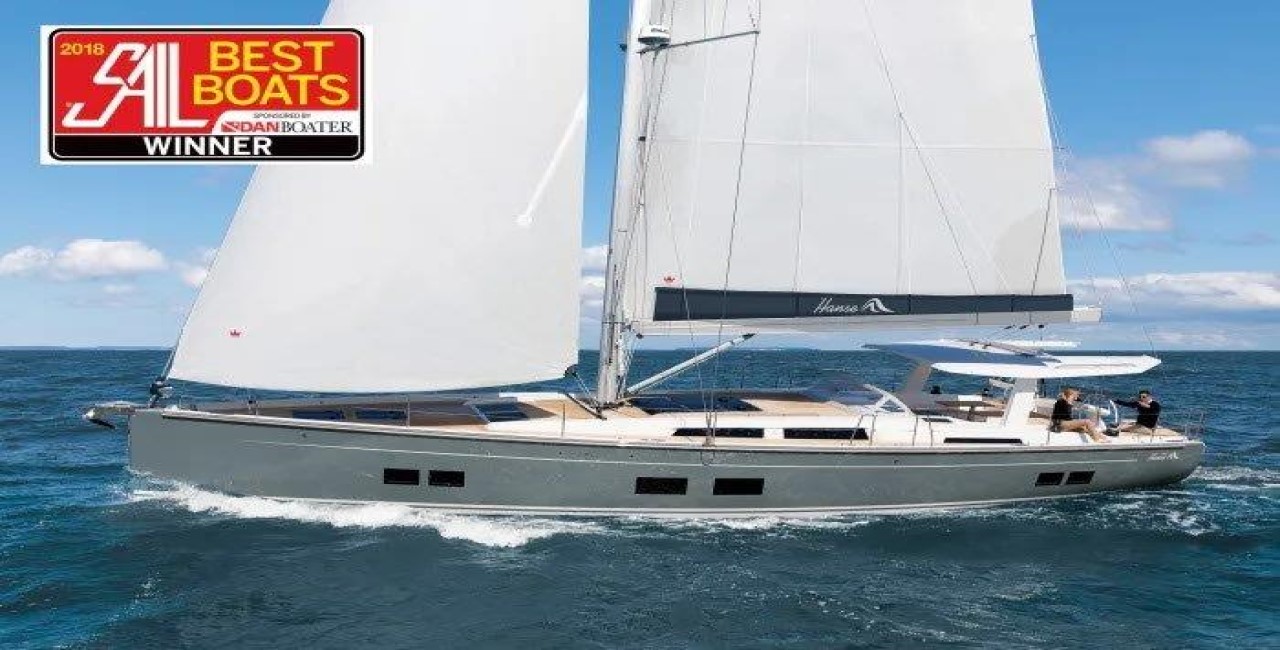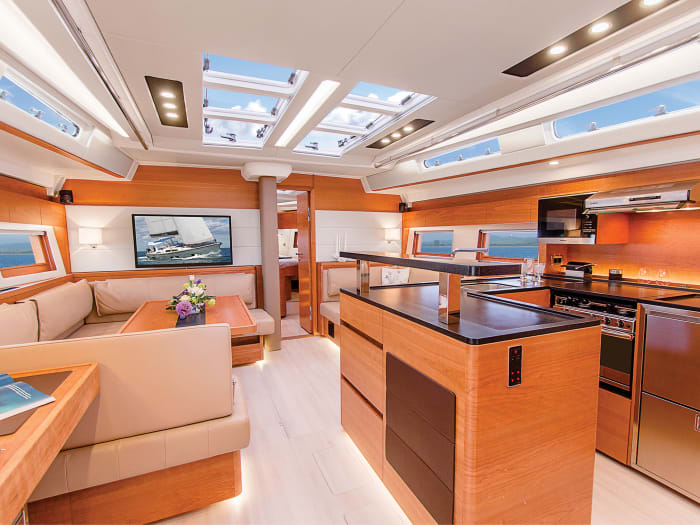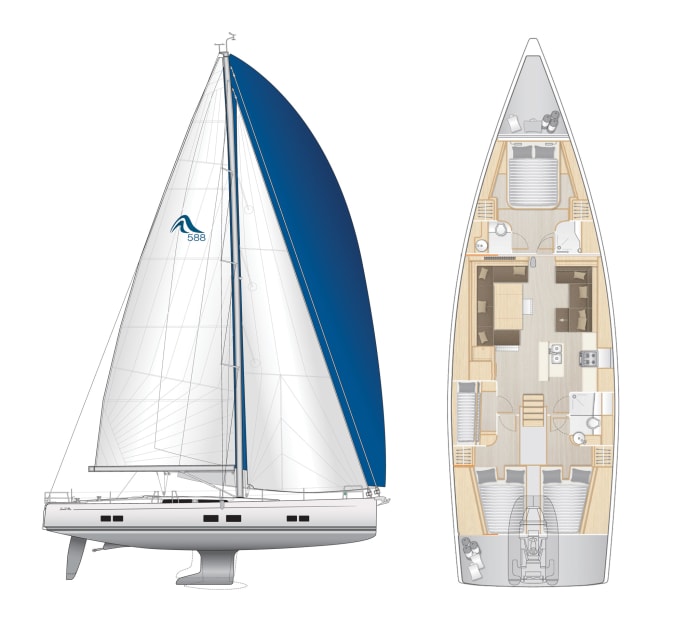By Charles J. Doane - Sail Magazine
Originally published March 13, 2018
This new full-size performance cruiser from Hanse replaces the successful Hanse 575, and includes updates and improvements developed with the help of input from active owners. With an extremely malleable interior (encompassing 72 possible variations) and a vast array of color, fabric and trim options, this is one mass-production boat of which it can honestly be said there are no two alike. The boat’s layout flexibility, thoughtful improvements, enhanced finish quality, fine sailing performance and aggressive price point all helped earn it a 2018 SAIL Best Boats award in the Flagship Monohull category.
Design & Construction
The hull is a balsa-cored fiberglass sandwich laminate set in polyester resin with its exterior layer set in vinylester for improved osmosis resistance. Areas around the chainplates are reinforced with carbon fiber, and interior bulkheads are vacuum-bagged composite structures that are fully tabbed into the hull. The cast-iron keel (of which there are three variations) is bolted into large metal backing plates bedded into the bottom of the hull with epoxy resin and surrounded by a robust structural floor grid. The single rudder is cored fiberglass with an aluminum stock and frame.
On Deck
Our test boat, which featured a striking purple hull, had an exceptionally clean deck, with no dodger or other cockpit shelter other than a foldaway bimini top. However, a carbon hard-top over the cockpit—Hanse calls it a T-Top—with a retractable canvas panel and an optional windscreen can be ordered if desired. The cockpit features twin Carbonautica wheels with independent Lewmar steering systems. Forward of these is a pair of twin cockpit tables either side of a central walkway, providing straight-line access from the companionway to the hydraulically controlled fold-down transom. Beneath the cockpit is a dinghy garage, remodeled from the 575 so as to accommodate a broader range of tenders.
Cockpit ergonomics are good. All lines run aft from the mast belowdeck to rope clutches and Lewmar winches set within easy reach of both helm stations. High cockpit coamings provide comfortable seating for guests relaxing in front of the helms out of the way of working crew.
Moving forward the deck is enclosed by a high bulwark that really frames the boat visually and offers great security in rougher conditions. The fact that there are no scuppers means all the water coming on deck will be routed aft, which saves the topsides from streaking. For added security, there is also a well-positioned grabrail along the sides of the coach roof, a welcome sight in this age of naked foredecks. All the way forward is a segregated sail locker that can also be configured as crew quarters.
Accommodations
Compared to the 575, the 588 boasts a more open saloon with larger hull portlights and improved finish quality. There is a total of 20 deck hatches, which let in scads of outside light, but will also pose something of a chore when closing up the boat for a squall. The overall effect, as is common now on Euro boats, is of a bright, open, luxury loft.
Our test boat had a fairly conventional layout, with a very large owner’s stateroom forward (fully soundproofed with a gasket on the door), a U-shaped galley to starboard, a U-shaped dinette to port opposite a short banquette seat and twin mirror-image cabins aft with full double berths. The aft cabins also had ensuite heads with separate shower stalls, and boasted lots of natural light and ventilation, as well as an abundance of headroom and vertical clearance over the berths.
As mentioned, there are many different ways to configure the interior. The forward stateroom, for example, can be split into two smaller staterooms, and there is a choice between a U-shaped galley or a walk-through galley with an island. A separate passage cabin or utility space can also be added, and the aft berths can be pointed in different directions. The list goes on...
Under Sail
We sailed the boat in moderate but changeable conditions off Oyster Bay on Long Island Sound, with the true wind blowing 12-16 knots. Our test boat came equipped with an anodized aluminum Seldén rig, a full-batten Elvstrøm FCL mainsail stowed in an in-boom Furlerboom system and a twin-headsail setup forward, with an Elvstrøm Code 0-type genoa controlled by a Reckmann electric furler at the stemhead. Just aft of that was a self-tacking Elvstrøm FCL jib on a manually controlled Seldén Furlex furler.
Our boat also came with the most shoal of the three keel options and a slightly truncated rudder, so I was surprised at how close to the wind we could sail. In the 13 knots of true wind, flying the full main and Solent jib, we comfortably pinched as high as 30 degrees off the apparent wind while maintaining boat speeds up to 7.5 knots. Cracking off a bit to a 42-degree apparent wind angle, the number on the knot meter swelled as high as 9 knots.
My two hosts, Peter McKenzie and Tom Bobbin from Hanse dealer McMichael Yachts, insisted we were a bit slow, as the hull was foul. However, I had to question this as we cracked off a bit more to a 55-degree close-reaching angle and still saw our speed surge repeatedly to 9.9 knots. Sailing even further off the wind I was equally impressed at how much speed we carried on a broad reach with only the Solent jib flying forward of the mainsail. Speeds at a fat 130-degree angle ranged from 7.8 knots to 8.2 knots. Even after we rolled up the jib, we still made a maximum of 6.8 knots under the main alone.
Through all this, we negotiated several gusts and quick wind shifts. Playing the main with vang and sheet adjustments while sailing on the wind was a simple matter, and we had no trouble keeping the boat on its feet. The helm, I found, has some weight to it, but the overall feel at all angles was very good. The wheel does need some attention, but this is well rewarded. Once focused, I found it easy to find a groove and stay in it. I also had no trouble steering through the gusts and shifts.
Under Power
Our test boat came equipped with a 110hp Volvo diesel engine (a larger 150hp power plant is also available) turning a standard three-blade Flexofold prop via a conventional shaft drive. For close-quarters maneuvering, we also had a pair of optional Quick thrusters, bow and stern, at our disposal.
I was immediately impressed with how quiet the engine was. The engine compartment, which is compact but easily accessed on three sides, is well insulated. On deck, it takes a careful ear to hear the thrum of the diesel below. Down below, even in the aft cabins directly alongside the engine bay, the sound is not at all intrusive.
Again, I had to wonder just how foul the hull could be. Heading out into the sound against 15 knots of true wind and some small chop, with the engine turning a lazy 1,920 rpm, we maintained an easy 7.5 knots of boatspeed. Turning later onto a more neutral heading in flat water with the wind on our beam we made 9.4 knots at 2,150 rpm. At maximum throttle, with the engine turning 2,740 rpm, we made 10.2 knots.
Backing down I found it took a couple of seconds for the prop to turn around and bite in the other direction. Once moving, however, the boat was easy to control. Moving forward with the helm all the way down, the boat turned easily within one boatlength.
Conclusion
Hanse was the first mass-production builder to move into the big-boat market in a big way, and it is maintaining a prominent position in this segment with the introduction of the 588. Owners have so many choices, they can easily make their boat unique to them. Couple that with fine sailing capability and a friendly price tag, and the 588 becomes a boat that demands attention.
Specifications
LOA 56ft 5in LWL 49ft 8in BEAM 17ft 1in
DRAFT 7ft 5in (shoal); 8ft 8in (standard); 9ft 4in (deep bulb) DISPLACEMENT 50,265lb (standard)
BALLAST 14,330lb (standard)
SAIL AREA 1,690ft²
AIR DRAFT 84ft 10in
FUEL/WATER (GAL) 137/203
ENGINE Volvo 110hp diesel
BALLAST RATIO 28 SA/D RATIO 20 D/L RATIO 183
DESIGNER Judel/Vrolijk & Co.
BUILDER Hanse Yachts, Greifswald, Germany, hanseyachts.com



